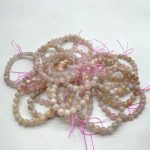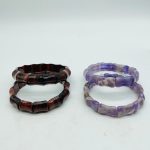Why Identifying Real Crystals Matters
Natural crystals have been prized for centuries for their beauty, healing properties, and spiritual significance. However, the influx of synthetic and imitation crystals in the market has made it crucial to distinguish between genuine and counterfeit ones. Identifying real crystals ensures the authenticity of your collection, maximizes their potential benefits, and protects you from financial loss.

Common Imitation and Synthetic Crystals
According to the American Gem Society, synthetic crystals are lab-created materials that mimic the composition and appearance of natural crystals. Common synthetic crystals include:
- Synthetic diamonds (cubic zirconia)
- Synthetic emeralds (lab-created emeralds)
- Synthetic rubies (lab-created rubies)
- Synthetic sapphires (lab-created sapphires)
Imitation crystals, on the other hand, are often made from inexpensive materials such as glass or plastic and are designed to resemble natural crystals.
Key Characteristics of Real Crystals
Identifying real crystals requires a keen eye and an understanding of their unique characteristics. Here are some key factors to consider:
1. Clarity and Imperfections
Natural crystals often contain inclusions, bubbles, or other imperfections that attest to their authenticity. Synthetic crystals tend to be flawlessly clear and may lack these distinguishing features.
2. Color and Radiance
The color and radiance of a crystal can provide clues about its authenticity. Real crystals often exhibit a rich, natural hue and may shimmer or reflect light in a unique way. Imitation crystals may have an artificial or overly consistent color.
3. Hardness
Natural crystals have varying degrees of hardness, which can be determined using the Mohs scale. An approximate measure of a crystal’s hardness can be obtained by scratching it with a household item, such as a nail or a knife. Real crystals resist scratching from softer materials.
4. Shape and Symmetry
Natural crystals often have distinct and symmetrical shapes that reflect their internal crystalline structure. Imitation crystals may have irregular or distorted shapes.
Scientific Tests for Identifying Crystals
In addition to visual inspection, scientific tests can provide conclusive evidence about a crystal’s authenticity. Here are common methods used by gemologists and crystal collectors:
1. Refractive Index Measurement
The refractive index (RI) of a crystal refers to the speed at which light passes through it. Different crystals have different RI values, which can be measured using a refractometer. An incorrect RI measurement typically indicates an imitation or synthetic crystal.
2. Spectroscopic Analysis
Spectroscopic analysis involves studying the interaction of light with a crystal. This analysis can reveal the presence of specific elements and impurities that help distinguish genuine from synthetic crystals.
3. Density Measurement
The density of a crystal is a measure of its mass per unit volume. Different crystal species have different densities, which can be determined using a balance scale. An incorrect density measurement may suggest an imitation or synthetic crystal.
4. Polarized Light Microscopy
Polarized light microscopy is a technique that uses the polarization of light to examine the internal structure of crystals. This analysis can reveal growth patterns and other characteristics that help determine a crystal’s authenticity.
Table 1: Physical Characteristics of Common Crystals
| Crystal Type | Hardness (Mohs scale) | Specific Gravity (g/cm³) | Refractive Index |
|---|---|---|---|
| Diamond | 10 | 3.52 | 2.42 |
| Quartz (Amethyst, Citrine) | 7 | 2.65 | 1.54 |
| Topaz | 8 | 3.53 | 1.63 |
| Emerald | 7.5 | 2.72 | 1.58 |
| Ruby | 9 | 4.03 | 1.76 |
Tips for Buying Authentic Crystals
Identifying real crystals is essential when purchasing them for your collection or for energetic use. Here are some tips to help you make informed choices:
- Purchase crystals from reputable dealers who provide certificates of authenticity or transparency reports.
- Be skeptical of crystals that are suspiciously inexpensive or flawless.
- Handle the crystals and examine their weight, texture, and imperfections.
- Use a loupe or magnifying glass to inspect the crystals for inclusions and other identifying characteristics.
- Consider having the crystals tested by a qualified gemologist or crystal expert if you have any doubts about their authenticity.
Benefits of Identifying Real Crystals
Identifying real crystals offers numerous benefits, including:
- Ensures the authenticity and value of your collection
- Maximizes the potential healing and spiritual benefits of the crystals
- Protects you from fraud and financial loss
- Allows you to make informed decisions based on accurate information
Table 2: Potential Healing Properties of Crystals
| Crystal Type | Potential Healing Properties |
|---|---|
| Amethyst | Calming, stress relief |
| Citrine | Motivation, creativity |
| Topaz | Confidence, communication |
| Emerald | Heart healing, emotional balance |
| Ruby | Energy, passion, vitality |
Table 3: Spiritual Uses of Crystals
| Crystal Type | Spiritual Uses |
|---|---|
| Amethyst | Spiritual protection, intuition |
| Citrine | Abundance, manifestation |
| Topaz | Clairvoyance, spiritual communication |
| Emerald | Heart chakra healing, love |
| Ruby | Passion, drive, manifestation |
Table 4: Innovative Applications of Crystals
| Crystal Type | Innovative Applications |
|---|---|
| Diamond | Biomedical sensors, quantum computing |
| Quartz | Energy storage, telecommunications |
| Topaz | Nuclear waste storage, medical imaging |
| Emerald | Lasers, optical fibers |
| Ruby | Laser technology, medical diagnostics |
Conclusion
Identifying real crystals is crucial to ensuring the authenticity of your collection, maximizing their benefits, and protecting you from fraud. By understanding the key characteristics of real crystals and utilizing scientific tests when necessary, you can make informed decisions and enjoy the beauty and power of genuine crystals.




























